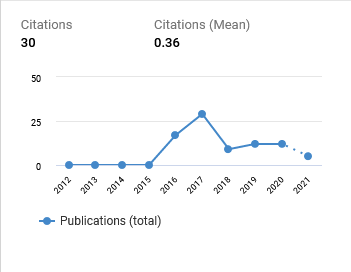Evaluation of BIPV performance based on the Greenship Standard
Towards Net Zero School Building
DOI:
https://doi.org/10.29080/eija.v8i1.1442Keywords:
BIPV, energy-mix, greenship, net zero building, on-site renewable energyAbstract
generated from a variety of sources, both renewable and nonrenewable. Switching from nonrenewable to renewable energy sources is one of many strategies that can be used to achieve net-zero buildings. In Indonesia, this strategy is very feasible due to its abundant renewable energy resources, particularly solar energy. This research presents a school building as the proposed case. The school, SCK Citra Garden, is chosen as the pilot project due to its access to solar radiation and its minimum shading conditions. Using Helioscope software, BIPV modelling was simulated on its roof, and the electrical energy output from BIPV was calculated. The substitution percentages of BIPV energy output for conventional electrical energy consumed by the building were then measured. This percentage was compared to the National Energy Mix target and Greenhouse Gas Standard to assess its performance towards net-zero school buildings. The result shows that BIPV has a good performance. Even though the substitution percentage is still below the national energy mix target, it exceeds the greenhouse gas standard target for on-site renewable energy tools.
Downloads
References
Beaudet, A. (2016, April 13). How to Read Solar Panel Specifications. AltE DIY Solar Blog. https://www.altestore.com/blog/2016/04/how-do-i-read-specifications-of-my-solar-panel/
Council, I. G. B. (2020). GREENSHIP Rating Tools Existing Building GREENSHIP Existing Building (EB). https://www.gbcindonesia.org/greens/existing
Lai, X., Dai, M., & Rameezdeen, R. (2020). Energy saving based lighting system optimization and smart control solutions for rail transportation: Evidence from China. Results in Engineering, 5, 100096. https://doi.org/https://doi.org/10.1016/j.rineng.2020.100096
Marszal, A. J., Heiselberg, P., Jensen, R. L., & Nørgaard, J. (2012). On-site or off-site renewable energy supply options? Life cycle cost analysis of a Net Zero Energy Building in Denmark. In Renewable Energy (Vol. 44, pp. 154–165). Elsevier BV. https://doi.org/10.1016/j.renene.2012.01.079 DOI: https://doi.org/10.1016/j.renene.2012.01.079
NASIONAL, S. J. D. E. (2019). SEKRETARIAT JENDERAL DEWAN ENERGI NASIONAL.(nd).
Pitts, A. (2004). Planning and Design Strategies for Sustainability and Profit: Pragmatic sustainable design on building and urban scales. Architectural Press.
RKS-IPB, D. (n.d.). Agenda riset bidang energi 2009-2012.
Sinaga, G. A., Mataram, I. M., & Partha, T. G. I. (2019). Analisis Pembangkit Listrik Sistem Hybrid Grid Connected Di Villa Peruna Saba, Gianyar–Bali. Jurnal SPEKTRUM Vol, 6(2).
Srinivasan, R. S., Braham, W. W., Campbell, D. E., & Curcija, C. D. (2012). Re(De)fining Net Zero Energy: Renewable Emergy Balance in environmental building design. In Building and Environment (Vol. 47, pp. 300–315). Elsevier BV. https://doi.org/10.1016/j.buildenv.2011.07.010 DOI: https://doi.org/10.1016/j.buildenv.2011.07.010
Srinivasan, R. S., Braham, W. W., Campbell, D. P., & Curcija, C. D. (2011). Energy balance framework for Net Zero Energy buildings. In Proceedings of the 2011 Winter Simulation Conference (WSC). IEEE. https://doi.org/10.1109/wsc.2011.6148032 DOI: https://doi.org/10.1109/WSC.2011.6148032
Susan, S, & Wardhani, D. (2020a). Building integrated photovoltaic as GREENSHIP'S on-site renewable energy tool. In Results in Engineering (Vol. 7, p. 100153). https://scholar.google.com/citations?view_op=view_citation&hl=en&user=Liut8i0AAAAJ&pagesize=100&citation_for_view=Liut8i0AAAAJ:r0BpntZqJG4C
Susan, S, & Wardhani, D. K. (2020b). Photovoltaic and Wind Turbine: A Comparison of Building Integrated Renewable Energy in Indonesia. In Humaniora (Vol. 11, Issue 1, pp. 51–57). https://scholar.google.com/citations?view_op=view_citation&hl=en&user=Liut8i0AAAAJ&pagesize=100&citation_for_view=Liut8i0AAAAJ:4JMBOYKVnBMC
Susan, Susan. (2017). Integrated Configuration of Folding Wall-BIPV at Office Building in Surabaya as Low Carbon Building Design. Humaniora, 8(1), 31–44. DOI: https://doi.org/10.21512/humaniora.v8i1.3694
Susan, Susan, Wardhani, D. K., Ariyanto, Y., & Harianto, E. (2021). Optimization of BIPV based on Electrical Energy Generated and Return of Investment. ARTEKS: Jurnal Teknik Arsitektur, 6(3).
Ubisse, A., & Sebitosi, A. (2009). A new topology to mitigate the effect of shading for small photovoltaic installations in rural sub-Saharan Africa. Energy Conversion and Management, 50(7), 1797–1801. DOI: https://doi.org/10.1016/j.enconman.2009.03.016
Yi, H., Srinivasan, R. S., Braham, W. W., & Tilley, D. R. (2017). An ecological understanding of net-zero energy building: Evaluation of sustainability based on energy theory. In Journal of Cleaner Production (Vol. 143, pp. 654–671). Elsevier BV. https://doi.org/10.1016/j.jclepro.2016.12.059 DOI: https://doi.org/10.1016/j.jclepro.2016.12.059

Downloads
Additional Files
Published
How to Cite
Issue
Section
License
Copyright (c) 2022 Susan Susan, Dyah Kusuma Wardhani, Yusuf Ariyanto, Eric Harianto

This work is licensed under a Creative Commons Attribution-ShareAlike 4.0 International License.
- Authors retain copyright and grant the journal right of first publication with the work simultaneously licensed under a Creative Commons Attribution ShareAlike License that allows others to share the work with an acknowledgment of the work's authorship and initial publication in this journal.
- Authors are able to enter into separate, additional contractual arrangements for the non-exclusive distribution of the journal's published version of the work (e.g., post it to an institutional repository or publish it in a book), with an acknowledgment of its initial publication in this journal.
- Authors are permitted and encouraged to post their work online (e.g., in institutional repositories, pre-print sites, or on their website) prior to and during the submission process, as it can lead to productive exchanges, as well as earlier and greater dissemination of published work.
































